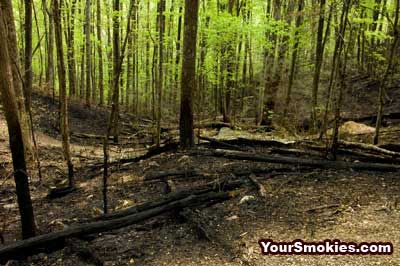Wild fires in the Great Smoky Mountains national park are inevitable and in fact in some cases even encouraged under controlled circumstances. This is not the case with this week's Laurel Falls Wildfire which threatened one of the parks most valuable natural resources as well as homes and businesses close by.

The Laurel Falls wild fire was set accidentally by an illegal campfire similar to the one pictures here I found 2 days ago in the Greenbrier section of the park. There was a wildfire warning the day this fire was made and since the weather conditions were right and there was plenty of fuel to feed a brush fire with all of the hardwood litter on the forest floor and beetle damaged trees, the fire quickly got out of hand.
Dozens and dozens of firefighters worked with hand tools making scratch lines and fire breaks to slow the spread of the wild fire, along with setting small controllable fires to burn up any fuel they could before the main fire reached the area.

Along with almost 90 men on the ground fighting the fire, a light helicopter dropped loads of water taken from a pond in Wears Valley on the area, while a 2 engine reconnaissance plane used a spotter to help control the ground crew and lead in the water taker plane as it would drop its load of water and flame retardant flown in all the way from Chattanooga.
The hiking trail to Laurel Falls is a short paved trail less than 1-1/4 miles long which takes you to one of the most attractive waterfalls in the Great Smoky Mountains national park. This section of the trail has a limited incline gaining about 600 feet to the falls and year round has some overlooks affording visitors a view of mountains within the GSMNP.
The Laurel Falls waterfall is quite impressive and is where most of the visitors who come to the most poplar hiking trail in the Great Smoky Mountains national park stop. In fact the Laurel Falls Hiking trail continues far past where it is paved and continues another 1-1/2 miles gaining another 950 feet in elevation before it reaches the next trailhead where you can take a short 1-1/2 round trip hike up to the peak of Cove Mountain.
The stretch of the Laurel Falls Hiking Trail past the falls contains largest concentration and some of the best old growth trees that can be accessed in the Great Smoky Mountains national park. These huge old growth trees were never logged as they were not accessible to the Little River Logging Company who clear cut large areas of this wilderness before it became a national park.
The first quarter of the way up the waterfall trail, other than the smell of an old campfire in the air you would never know that a huge battle against a wild fire was just fought on this trail. Why look to the left and you will see one the first flaming azaleas still blooming in the park.

The last 2/3rd of the trail are another story. Clear fire damage is visible on both sides of the Laurel Falls Hiking Trail. Huge charged logs lay on the ground many of which are cut into more manageable sizes with the use of a chain saw.
There is now an obvious absence of normal understory plants and small bushes in most areas and blacked pine cones and scorched empty soda cans previously hidden on the first floor can now be seen scattered about on the forest floor or mountainside on the rest of the way the waterfalls.

Though it looks terrible now, this damage along the hiking trail is very minimal as most of the mid and upper level canopy has remained untouched and bright green in huge contrast the to the black scorched forest floor.
By the end of the summer, other than the scorched logs and tree trunks, most of the understory will have grown back and the rhododendrons and other bushes should be fine by next spring.
Luckily even though almost 270 acres of this beautiful forest between Elkmont and the Sugarlands was damaged by the wildfire, the area past the Laurel Falls remains untouched.
Once you pass the falls and hike up the double switchback to the other side of Chinquapin Mountains on the back end of the trail, larger trees become more and more numerous and the wildflowers more abundant. A few hundred yards more and you start to see the parks old growth giants scattered about.
This forest has always felt more primordial to me with its huge trees, dark green ferns and heavy low cover of wildflowers and is one of the most tranquil areas of the entire Great Smoky Mountains national park. I have hiked all of the trails in the park and time and time again I find myself taken aback by the beauty of this trail.

Within a few minutes along this section of the trail you forget you just went such major destruction. Back on this section of the trail you smell the fresh green of spring and the smell of old stale smoke is no longer discernible.

Today you can see plenty of wildflowers which have already peaked in other sections of the park including: Large Flowered Trillium, White Erect Trillium, Painted Trillium (pictured below), White Violets, Hepatica, Rue Anemone, Silverbell, Wild Strawberry, Star Grass, Smooth Yellow Violet, Common Blue Violet and Squaw root coming up through the leaves everywhere.

Thanks to the valiant efforts of our firefighter, one of the most precious resources on the Great Smoky Mountains has been saved form destruction. The economic cost to fight the Laurel Falls Wild Fire will be staggering.
No comments:
Post a Comment